Digital Camera Short List
Last Update: 12 March 2006
New!
Digital SLR Selection Criteria
Eliminate the Junk and Make an Informed Decision
Table of Contents
Currently Available Cameras Recommended by the Digital Camera Academician
![]() = Bad
= Bad ![]() = Good
= Good
![]() = Okay
= Okay
Prices Listed are Certain to Change Often!
| Lowest Street Price I've Seen from
reputable dealer Always check out web retailers by going to http://resellerratings.com. Do not trust any other rating system of web retailers. A price that seems too good to be true, usually means a disreputable vendor. |
Model |
|
|
|
|
|
|
|
|
|
|
Photo |
| $307 (Amazon.com) |
Canon SD450 (Ultra-Compact) |
5 | 3x |
Secure Digital
|
Li-Ion
|
Yes
|
No
|
Yes
|
Yes
|
Yes
|
2,5" |
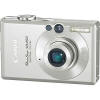 |
| $398 (Amazon.com) |
Canon SD550 (Ultra-Compact) |
7.1 | 3x |
Secure Digital
|
Li-Ion
|
Yes
|
No
|
Yes
|
Yes
|
Yes
|
2.5" |
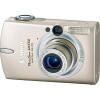 |
| $470 (Amazon.com) |
Canon S80 (Sub-Compact) |
8 | 3.6x |
Secure Digital
|
Li-Ion
|
Yes
|
No
|
Yes
|
Yes
|
Yes
|
2.5" |
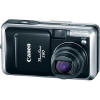 |
|
$230
(Amazon.com) (Available on April 30th 2006) |
Canon A530 (Entry-Level Compact) |
5 | 4x |
Secure Digital
|
2
x AA
|
Yes
|
No
|
Yes
|
Yes
|
Yes
|
1.8" |
 |
|
$300 (Amazon.com) (Available on April 30th 2006) |
Canon A540 (Mid-Level Compact) |
6 | 4x |
Secure Digital
|
2
x AA
|
Yes
|
No
|
Yes
|
Yes
|
Yes
|
2.5" |
|
| $261 (Amazon.com) |
Canon A610 (Amateur Compact) |
5 | 4x |
Secure Digital
|
4
x AA
|
Yes
|
No
|
Yes
|
Yes
|
Yes
|
2" |
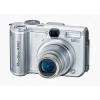 |
| $320 (Amazon.com) |
HP R717 (Amateur Compact) |
6 | 3x |
Secure Digital
|
Li-Ion
|
Yes
|
No
|
Yes
|
Yes
|
No
|
1.8" |
 |
|
$350
(Amazon.com) (Available on April 30th 2006) |
Canon A700 (High-end amateur Compact) |
6 | 4x |
Secure Digital
|
2
x AA
|
Yes
|
No
|
Yes
|
Yes
|
Yes
|
2.5" |
 |
| $560 (B&H Photo) |
Canon G6 (Prosumer Compact) |
7 | 4x |
Compact Flash
|
Li-Ion
|
Yes
|
Yes
|
Yes
|
Yes
|
Yes
|
2" |
 |
| $380 (Amazon.com) |
Sony H1 (zlr or "Megazoom") |
5 | 12x |
Memory Stick
|
2
x AA
|
Yes
|
No
|
Yes
|
Yes
|
Yes
|
2.5" |
 |
| $572 (Amazon.com) |
Panasonic FZ-30 (zlr or "Megazoom") |
8 | 12x |
Secure Digital
|
Li-Ion
|
Yes
|
Yes
|
Yes
|
Yes
|
No
|
2" |
 |
|
$646 (kit) (Amazon.com) $525 (body) (Amazon.com) |
Nikon D50 (Entry Level D-SLR) |
6 | N/A |
Secure Digital
|
Li-Ion
|
Yes
|
Yes
|
No
|
No
|
Yes
|
2" |
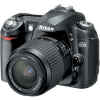 |
|
$845 (kit) (Amazon.com) $796 (body) (Amazon.com) |
Canon EOS-350D (Amateur D-SLR) |
8 | N/A |
Compact Flash
|
Li-Ion
|
Yes
|
Yes
|
No
|
No
|
Yes
|
1.8" |
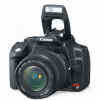 |
|
|
Nikon D70s (Amateur D-SLR) |
6 | N/A |
Compact Flash
|
Li-Ion
|
Yes
|
Yes
|
No
|
No
|
Yes
|
2" |
 |
| $1615 (kit with 18-70mm IS lens) (Amazon.com) |
Canon EOS-20D (Prosumer D-SLR) |
8 | N/A |
Compact Flash
|
Li-Ion
|
Yes
|
Yes
|
No
|
No
|
Yes
|
1.8" |
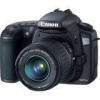 |
|
|
Nikon D200 (Prosumer D-SLR) |
10 | N/A |
Compact Flash
|
Li-Ion
|
Yes
|
Yes
|
No
|
No
|
Yes
|
2.5" |
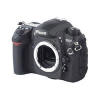 |
Recommendations Based on Valued and Informed
Opinions
I'm often asked what digital camera to buy. Many people decide how much money
they can spend and then go looking for cameras in that price range that suit
their needs. There are decent
digital cameras available starting at about $200, and prices go as high as $8000
for a full-frame professional D-SLR (without lenses or flash). The recommendations below take
into account price as well as features.
The digital camera review sites, such as http://dpreview.com and http://steves-digicams.com/, serve a useful purpose, but they can be overwhelming as they go into great depth without actually making recommendations on what to buy in each price range (or what to avoid!). As Phil Askey (dpreview.com) wrote in one review, "So which one should I buy? A question I get asked several times a day, and I wouldn't like to say." Many people come away from those sites more confused than ever, but those sites can't really make actual recommendations without offending the manufacturers. On the other hand, the Digital Camera Short List provides actual recommendations, taking into account the many trade-offs inherent in making a wise choice. This web site is for people that just want to know the best choice in their price range--without having to research a gazillion different models.
DCResource is one excellent web site for feature comparison, with the best comparison engine for narrowing down your selection based on features. I especially like the fact that they recognize the importance of an AF Assist Lamp, and allow its inclusion as a requirement.
Zoom
You want a minimum of 3X optical zoom.
Megapixels
You want a minimum of 4 megapixels. Don't go overboard with
megapixels. Two recent 8Mb models, the Sony DSC-F818 and Canon Powershot Pro 1, have
unacceptably high noise levels and hence were not included as recommendations.
It's very hard to go over 6Mp with a CCD non-full-frame sensor and keep the
noise levels acceptable, especially at higher ISO settings. Unfortunately, Canon
hasn't yet migrated its CMOS sensor technology down from its SLRs.
Lens Adapters
These are not really lenses per-se, but adapters that extend the original
lens in either the wide-angle, or telephoto direction. Often an extension tube
must be mounted onto the camera, then the lens adapter mounts to the tube.
See the
Filters and Lens
Adapters for Point and Shoots section for more details.
Hot Shoe
This enables the use of an external flash. The higher-end compact models such as
the Canon G6, ZLRs, and SLRs have a hot shoe. You can also use an external
flash, that is optically linked to the pre-flash on the camera, on most cameras.
Auto-Focus Assist Beam
An auto-focus assist beam is a very useful feature for
indoor and low light shots. This beam lights up the scene during focusing, so
accurate focusing is possible in low light (where the flash will provide sufficient
illumination at the time of the actual photo). Canon pioneered this feature, and has it on most
models (even the inexpensive A60 had it). Other manufacturers are now beginning
to add this feature, but often it isn't found on the lower end models. You can
disable it for outdoor shots. Do
NOT buy a non-SLR camera without an AF assist lamp (this narrows down
the choices considerably).
Batteries
When possible, choose cameras with included
Lithium-Ion rechargeable batteries, as opposed to cameras that uses AA
batteries. See the Power Sources section for
more details.
Memory Card Type
The best choice is Compact Flash (CF). The second best choice is Secure
Digital (SD). See the section for more details. Most smaller cameras have
moved to SD, while most D-SLRs continue to use Compact Flash. A few cameras use
xD which is a small form factor, more expensive type of card. Sony uses Memory
Stick, which is a definite disadvantage, but not a reason to avoid Sony
completely.
Shutter Lag
Shutter-lag is the
most annoying aspect of digital
photography, where the picture is not taken for up to a second after the shutter
release is pressed. You're guaranteed to miss a lot of action shots unless you
opt for one of the few cameras that have overcome this problem. See the
Shutter
Lag section for more details.
LCD Size
In general, bigger is better, though battery life suffers slightly with the
larger displays.
Optical Viewfinder
While it's rare to find even a point and shoot camera that lacks an optical
viewfinder, there are still several cameras that would otherwise be acceptable
if not for the omission of this vital feature. The Fuji F10 and F11 get good
reviews for image quality, but the lack of an optical viewfinder eliminates them
from consideration.
Docks
In certain uses, docks can be a very useful feature. Placing the camera on the
dock can automatically transfer the images from the camera to the computer, as
well as charge the internal camera battery. It's a good usage model for
technically unsophisticated individuals. as well as for small children.
Digital Cameras for School Classroom Use
This subject comes up fairly often. As I have one elementary school age child, and try to help out in the classroom as time allows, I have a lot of experience with this issue, so I added this special section. This information also applies to buying cameras for kids, and for non-technically savvy adults, with the goal being to minimize the amount of time that must be spent providing support the user. A parent or child that can do things themselves makes everyone happier! I was particularly pleased when my 80 year old mother was able to e-mail pictures to us, with the dockable camera I gave her. I just can't imagine her dealing with memory card readers, external battery chargers, etc.
What to Look For in a Digital Camera for Elementary School Classroom Use
1. Ability to Transfer Images without Opening the Camera and Removing the Memory Card
You don't want to have young students constantly removing the memory cards. Small memory cards are easily lost. Cameras typically have flimsy doors or covers for the memory card slot, that are easily broken. Children can insert all sorts of foreign (or domestic) objects into the memory card slot. While SD connectors are more reliable than Compact Flash connectors, there are still issues with them, especially the mechanical write-protect switch.
Image transfer can be accomplished by the use of a USB cable, the use of a dock, or wirelessly using BlueTooth or 802.11.
2. Ability to Charge the Batteries without Opening the Camera and Removing Them
You do not want to have the students removing and replacing batteries. Battery doors are fragile, and not designed for abuse. Battery doors are one of the most commonly broken items on digital cameras, especially when the battery door holds AA batteries into place with pressure.
Individual AA cells are easily incorrectly inserted, both in a camera and in a charger. If you get a non-dockable camera, with batteries that must be charged outside the camera, avoid cameras that use AA batteries. The last thing you want is for kids to be fumbling with multiple batteries, trying to keep track of which individual cells are charged or discharged, and having to deal with the problems inherent with AA batteries. Li-Ion batteries are a single pack that cannot be inserted incorrectly, and usually the battery door is not what is holding the battery in place in the camera.
Cameras
with docks almost always charge the batteries inside the camera. Most
non-dockable cameras cannot charge the batteries inside the camera.
3. Minimum of moving parts.
You do not
want swivel screens. You do not want pop-up flashes, etc. These types of
things are easily broken by small children.
4. Ruggedly Built Camera
Look for a camera with a stainless steel body as opposed to a plastic body. This isn't an absolute requirement, but it the steel cameras are less susceptible to some types of damage.
5. Simplicity
Don't worry about advanced features such as manual controls, add-on lenses, filters, external flashes, etc. These will not be used in the classroom. Students that really want to learn the nuances of photography at that age will be doing it outside the classroom.
6. Basic No-Compromise Features
Don't give up basic no-compromise features such as an optical zoom, and an AF assist lamp. These are essential, even for young students.
7. Docks Rule
A dock is the preferred solution for school use. As pointed out, a dock simplifies both charging and image transfer. Additional docks can be purchased to equip multiple computers with the ability to easily transfer images, though dedicating a single computer to be the download and charging station may be preferable if there is no shortage of computers.
8. So what's out there that meets these requirements?
Actually very little. There are many cameras with docks. There are many cameras with steel bodies. There are very few cameras with both. The HP R series (R707, R717, R817) are the best option. The R717 is well priced at $319 from Amazon, including the dock, a memory card, and a rechargeable Li-Ion battery. Google "camera dock steel" and you'll find that HP is the only manufacturer that comes up. Fuji and Kodak also make dockable cameras, though they don't have any with steel bodies.
Print Size Versus Megapixels
This is an oft-debated subject. I have created the table
below as a general guide. When taking web-image photos with a higher resolution
camera you should reduce the resolution in order to not have large image files.
I have removed 1Mp, 2Mp, and 3Mp as the low end of digital cameras is now at 3Mp.
When you want very large prints, it's best to use a digital SLR, due to its
larger sensor and lower noise. If you're doing pictures for web sites, you can
reduce the quality of the compression to get smaller images.
| Web Image | 4x6 | 5x7 | 8x10 | 11x14 | 16x20 | |
| 4 Mp | ||||||
| 5 Mp | ||||||
| 6 Mp |
SLR |
SLR |
||||
| 7 Mp | SLR | SLR | ||||
| 8 Mp | SLR | SLR |
Digital cameras come in many different physical sizes. All things being equal, the quality of photographs is higher with the larger cameras, due to the larger sensors and larger lenses. I use seven different categories for size (other reviewers have different classification systems).
Lenses
Lenses vary both in quality and field of view. Most buyers want a
zoom lens. Some very small and very low end models lack an optical zoom lens. I
do not recommend any of these models. Digital-only zoom should be avoided.
For SLRs, be very careful about the lenses that are bundled with the cameras. The Canon EOS-300D and Nikon D70, are sold body-only, body plus a Canon or Nikon bundled lens, or bundled with a cheap lens (Sigma, Tamron, Tokina, etc.) by the retailer .
When buying additional lenses for the SLR, be especially wary of the lenses offered by second and third tier lens manufacturers. For example, Sigma make a large variety of lenses for Nikon and Canon, some of them okay, many of them are not. The build quality and optics on the lenses from the second and third tier lens manufacturers are almost always not as good as the build quality and optics on the Canon and Nikon lenses. In some cases, the price difference is so large that it may be worth it to go with the lower end lenses, but be aware of the significant differences. "You get what you pay for," is very true when it comes to lenses. Canon and Nikon have professional and consumer lines of lenses, as does Sigma. In general, the Sigma professional line is comparable to the Canon and Nikon consumer lines, and Sigma has nothing that compares with the Canon and Nikon professional lines.
Filters and Lens
Adapters for Point and Shoots
Some non-SLR digital cameras have ways to attach filters and lens adapters
(wide-angle and telephoto). These may be accessories from the manufacturer or
from a third party. Often, the third-party accessories are superior. I.e., on
the Canon G series,
adaptertubes.com has
a superior product that not only doesn't block the flash and sensors, but that
takes more commonly available filters, and a less expensive Olympus wide angle
lens. The Canon A series (A60, A70, A75, A80, A85, A95) is fairly unique in that is a
lower priced line that has the capability for lenses and filters. The Canon S410
and S500 have an after-market adapter available only from Adorama
(http://www.adorama.com/ICALAS400.html).
Also see
http://www.2filters.com for adapter tubes and lenses.
Shutter Lag
One very annoying aspect of digital
cameras is the lag time between the time you press the "shutter
release" button, and the time the CCD adjusts the contrast, and the camera takes the picture
(this is in addition to any time doing auto-focus). On
many cameras this time is close to 1 second, which means that you will be unable
to take action shots (i.e. an attempt to photograph a kid on a
moving merry-go-round will invariably result in a photo of someone else's kid,
or the butt of a horse!).
Power Sources
When possible, choose cameras with
included Lithium-Ion rechargeable batteries. Li-Ion batteries give you a much more
convenient, dense, and light power system. Li-Ion batteries have a much longer
shelf life during periods of non-use.
As cameras become smaller, and consumers demand longer battery life, the number of AA powered cameras is dwindling. If you really want an AA powered camera, the Canon A520 and A610 are good choices.
For more information about Li-Ion versus NiMH AA batteries, pleas visit the premier web site for this subject at http://batterydata.com.
For information on NiMH batteries and chargers, please visit the premier site for this subject at http://nordicgroup.us/chargers.
Storage Media
For storage, Compact Flash (CF) is the most economical and comes in the
largest capacities (as well as hard drives that are the same size). Secure Digital (SD) is
the next best choice, and is what is being used in most smaller cameras (except
Sony) due to its
smaller physical size.
Sony Memory Stick and xD are less
desirable. Sony has finally capitulated to Compact Flash in their DSC-F828 model
(offers both Compact Flash and Memory Stick), but there other models use only
Memory Stick. The huge success of the Canon
Digital Ixus/Digital Elph is due in part to it being the smallest camera that
uses Compact Flash cards.
The type of storage media is usually not the deciding factor in the selection of a camera, unless you expect to need large amounts of memory for extended trips, or for professional use.
Compact Flash memory goes on sale a lot, and has a lot of rebates. Expect to pay $25-30 for 256MB, $40-50 for 512MB, and $70-90 for 1GB. Be very careful about overpriced memory from New York City camera retailers. Amazon.com and Costco usually have the best prices on memory.
Some older cameras use a storage format called "SmartMedia." These cameras should be avoided. SmartMedia is no longer widely available, and is limited in capacity. There are no new cameras being manufactured that use SmartMedia, but sometimes these cameras pop-up on TV shopping channels and closeout web sites.
I include only cameras that use Compact Flash or SD.
Movie Clips
Most still cameras provide limited ability to record short video clips, often
with audio included. Usually it's low resolution (320x240), but some newer models
now do 640x480. There are some very new models, just released, that can
record in MPEG-4 format, which highly compresses the video without affecting the
quality of the recording by a noticeable amount. This enables much greater
storage capacity. The Sanyo DMX-C1 is the first device that combines decent
still-picture capability (3 Mpixel) with MPEG-4 video recording.
Sweet Spot for Digital Cameras
The sweet spot for digital cameras is in 5-8
megapixel compact and ultra-compact models with 3x optical zoom. These are
available for $180 to $550.
Warranty Issues when Out of
the Country of Purchase, and Grey Market Repairs
Be careful about purchasing some
brands of cameras outside your home country, and beware of potential problems if
visiting one country with a camera purchased in another country. While Canon is
very good about repairing cameras brought in from outside the U.S., and even has
been known to repair, in-warranty, grey-market cameras bought in the U.S., not
all manufacturers are so amiable. Nikon is particularly averse to repairing any
camera that it believes is grey-market, even out-of-warranty repairs for a fee.
Sometimes a U.S. consumer will inadvertently buy a grey market product; this is
the fault of the manufacturer (who isn't controlling distribution), not the
consumer.
If you have a Nikon camera that you cannot get Nikon's factory service center to repair, try going to an independent Nikon service center. You can find a list of these service centers at: http://nikonusa.com/fileuploads/pdfs/Nikon_repair_list.pdf.
You may want to consider warranty issues when you decide on a camera. It would be a big hassle if you bought a camera in one part of the world, and needed repairs in another part of the world. You might need to carry your receipt with you, even for repairs that you are willing to pay for out of your own pocket!
D-SLRs and Lenses for
D-SLRs
If buying a digital SLR, look not only
at the camera body, but at the available lenses as well. Often, the driving force in
the choice of a Canon versus a Nikon D-SLR, is whether the buyer has a
collection of compatible lenses from their film SLR.
Canon makes three lenses that fit ONLY the 20D and 350D SLR. These are the EF-S 18-55, EF-S 10-22, and EF-S 17-85 IS. Due to the crop factor, the actual 35mm equivalent range of these lenses are 29-88, 16-35, and 27-136, respectively. The rear elements of these lenses are closer to the sensor than is possible on a full frame film or digital camera (the full size mirror on a full-frame SLR would hit theses lenses, and Canon has made it impossible to even mount these lenses on incompatible cameras).
If you buy a Canon or Nikon D-SLR, stick with lenses from the same manufacturer. There are many companies that make low-end lenses that are usable with Canon and Nikon SLRs, including Sigma, Tamron, Quantaray, Tokina, Vivitar, etc. Without exception, these lenses are not as good as what is sold by Canon and Nikon. It is a false economy to buy poor quality lenses. Ditto for flash attachments.
Click for Digital SLR Selection Criteria
Docks
Many Fuji, Kodak, and HP cameras are available with docks. The dock
typically not only provides a convenient connection to the computer, it also
recharges internal rechargeable batteries. For individuals that are not terribly
computer literate, or handy with cabling and charging, the docks are an easy way
to simplify things. However when traveling you may want to carry a separate
charger and interface cable that aren't as large as the dock. These are almost
always included, or available at extra cost.
There is something to be said for a system where you just drop the camera into the dock when you get home, and the pictures are transferred to your computer and the camera gets charged up, without fumbling with chargers, media readers, and USB cables. It's a good system both for kids and for other non-techies. Unfortunately, none of these camera/dock systems represent the best value in terms of image quality and price, and none are included on this list.
Prints
Prints from a digital camera can be
produced on a photo quality printer connected to your computer or at a
photo-lab. The cost of making your own prints is higher than having them made at
a place such as Costco, Wal-Mart or your local drugstore. This is because of
the cost of ink and paper (not to mention the initial fixed costs). Also,
lab-produced prints will last much longer (despite wild claims about 50 year inks).
It is interesting to note that prints from film and prints from digital are
now produced on the same equipment. This is because the way film is processed
commercially is to develop it, scan and digitize the negatives, and make prints from the
scanned images. You can edit your images prior to having prints made, or you can
just take the memory card straight from the camera, put it into the kiosk, and
choose which images you want to print.
Costco now offers the ability to upload photos directly to photo centers in Washington, Texas, Oregon, California, and Utah, see http://www.costco.com/photocenter/photocenter.aspx?cat=2781. Walgreen's lets you send your pictures to any of their stores. Very convenient for pick-up by friends and relatives in other cities, and Walgreen's is extremely fast for prints, as little as ten minutes.
Where to Buy
Use
www.pricegrabber.com
and www.froogle.com
to check on prices, but be very careful about web retailers. Note that
Amazon
doesn't show up in these price comparison engines, and
Amazon is often the lowest priced source, and includes free shipping. Amazon
often has special deals for future credits in their Electronics department,
or % off deals, depending on how much you spend (i.e. they had a $150 credit when I bought my
20D).
Always check out web retailers by going to http://resellerratings.com. Do not trust any other rating system of web retailers.
Buydig.com is pretty reliable and often has the best price, and sometimes has free shipping. However, lately buydig.com has not been listing the price for some of the more popular cameras, they only list it with kits that include accessories. Also check bhphoto.com, adorama.com, amazon.com, and dell.com. Sometimes you get a better price if you go through Amazon for Adorama (rather than going directly to the Adorama site). Pictureline is a reputable Salt Lake City store that does on-line sales, and is not well known, and hence more likely to have the hard-to-find cameras in stock.
Also check TechBargains.com to see if the camera you're interested in is on sale anywhere. The retailer with the best price will vary by model, and will vary over time. The prices that I list are probably all wrong the day after I edit them.
Dell often has coupons and discounts that bring down their prices significantly (they have 10-15% off most digital cameras at least twice a month, and often have coupons for a fixed dollar amount that can also be applied). Once a year, Microcenter has a 20% off sale which is pretty good for digital cameras, and brings their normally high prices down below many on-line retailers, even after paying sales tax.
Costco.com also often has fairly good prices, and sometimes includes extras such as a spare battery, or a large memory card, which makes up for the slightly higher prices. Costco has great return policies too.
The New York City mail order outfits often have very high prices on accessories, including spare batteries and memory cards, despite their low prices on the actual cameras. Don't be tricked into ordering over-priced and often poor quality accessories. The sleazier outfits will simply refuse to sell you just the camera, even though it appears on their web site (after you order, there will be problems with your order and they will call you, at which time you will be pressured to buy high-priced accessories).
I have included direct links to the specific camera on Amazon, Adorama, and Buydig. If buying from Adorama or Amazon, I appreciate your clicking the links on my page to go directly to the specific cameras at Amazon and Adorama, since I receive a small kickback for referrals.
For extra batteries, the best source is SterlingTek, at http://sterlingtek.com
Why so Many Canon Recommendations?
No, I don't work for Canon, or even have
stock in the company. Canon leads the pack because they have a knack for doing
the best job in terms of balancing features. Canon balances sensor resolution,
lens quality, power sub-system, and storage media type. Even Canon's inexpensive
models usually have an auto-focus assist beam, a very important feature. Canon's
A series is one of the only lines of inexpensive cameras that still features the
option of manual controls, and includes AF assist on all models.
The Canon A series has been divided into three distinct levels of cameras. The entry-level A530 features a 5 megapixel sensor, a 1.8" display, and runs on two AA batteries. The mid-level A540 features a 6 megapixel sensor and a 2.5" display.
Digital SLR Selection Criteria
When looking for a digital SLR, you should use the "Absolute Requirements" list to help narrow down your choices. These requirements are based on all the complaints of users and reviewers. Fortunately, there are enough models available that meet these requirements that it isn't necessary to compromise on any of the absolute requirements, even though in some cases it may be worthwhile to do so. There is a very good web site that deals solely with digital SLRs, at http://digitalslrinfo.com.
Click for Digital SLR Selection Criteria
Affiliate Links
I pay for the hosting and domain of this
site out of my own pocket, and don't take advertising, unlike most of the other
digital camera sites.
If you found this web site helpful, and you are buying from Amazon or Adorama anyway, it would be appreciated if you enter their web sites via the links in the able above (direct links to the product are best). Alternatively, use the links below to enter the sites.
|
The Amazon.com Visa Card is a pretty good deal, with a 3% discount, paid in Amazon gift certificates, for purchases made at Amazon.com. You get a $20 credit for your first order. You earn three points for every dollar you spend at Amazon and one point for every dollar you spend elsewhere. After 2500 points ($834 spent at Amazon) you get a $25 Amazon Credit. There is no annual fee. The Interest rate isn't very good, so this is not a card to keep a balance on. We appreciate it very much when you use the link below to sign up for the Amazon Visa Card. |

Travel Tripods Looking for a Travel Tripod? Check out: http://nordicgroup.us/tripod/
NiMH Battery Chargers Looking for NiMH Battery Chargers? Check out: http://nordicgroup.us/chargers
Battery Information Information on Proprietary Li-Ion versus NiMH AA Batteries. Check out: http://batterydata.com
© 2006, The Nordic Group